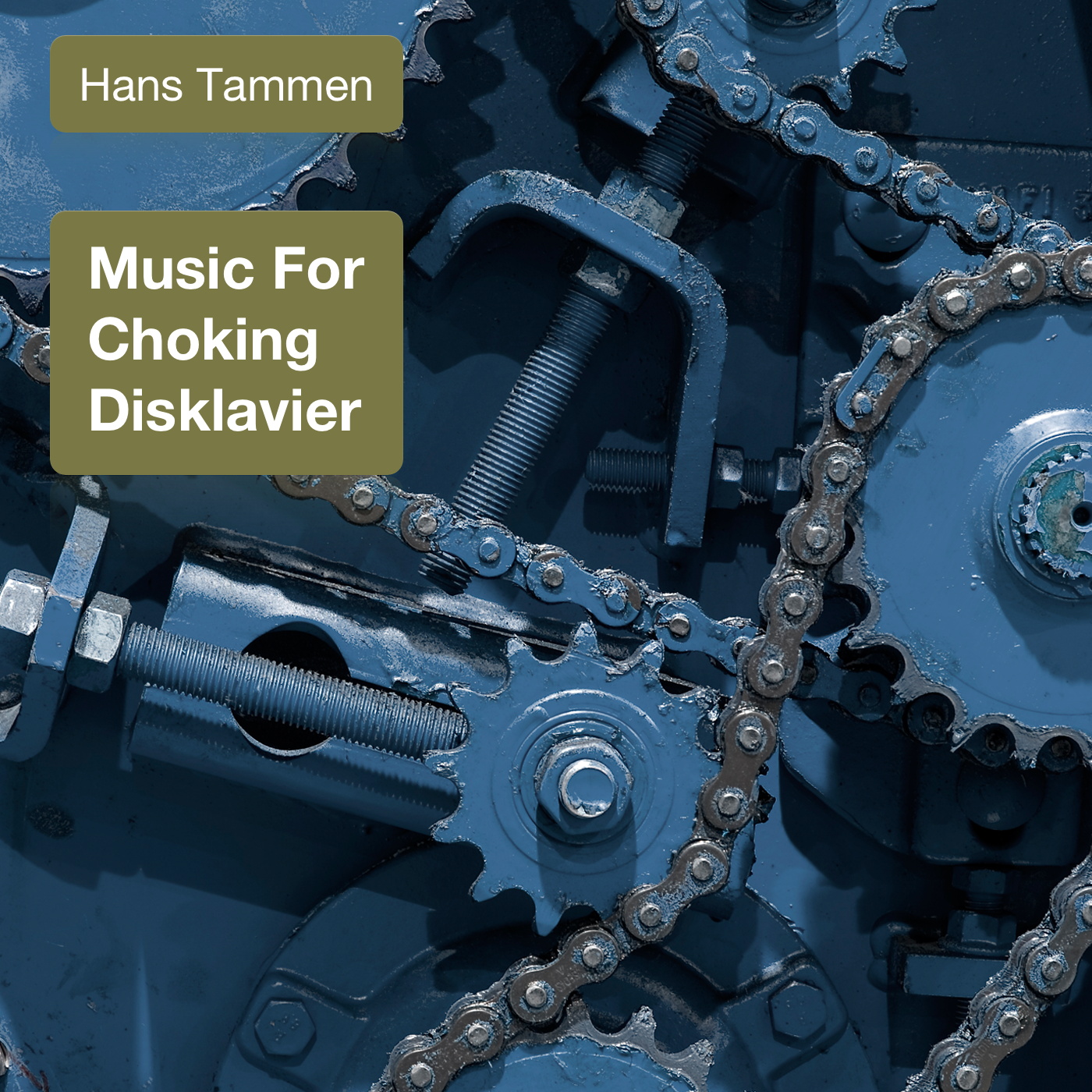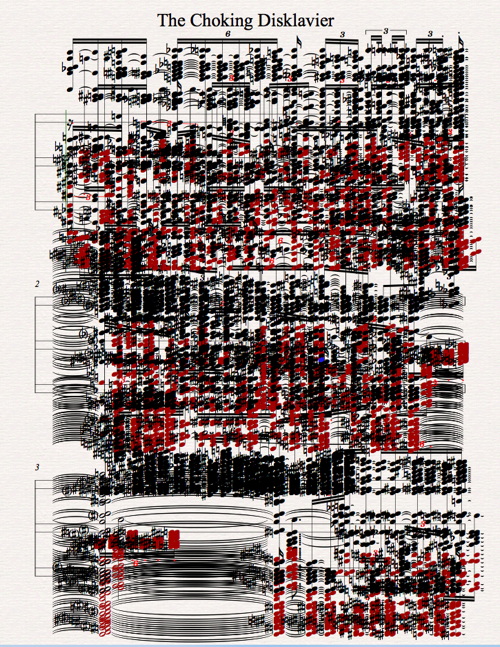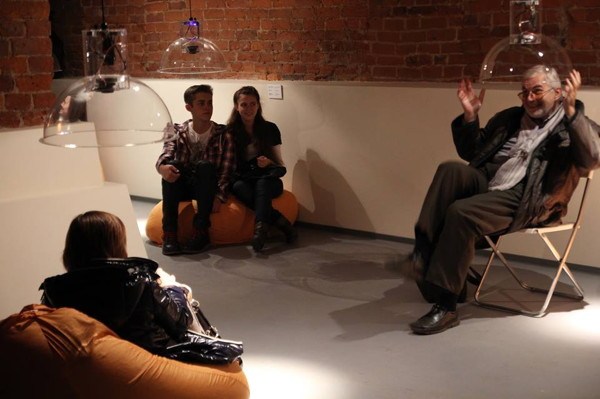
CD THE CHOKING DISKLAVIER
Clang 031, recorded April 2006 at Brooklyn College, New York, recording engineer Yonatan Niv, mastering by Paul Geluso. Published on Clang November 2015. All compositions by Hans Tammen. Total Time 44:30
“…an infernal rhythm machine” Fabrice Vanoverberg, Rifraf
Buy CD from my webstore here.
More information / buy digital at Clang website here.
Listen to the album (and buy) on Bandcamp further down on this page.
Cover photo by Heim/iStockphoto
Imagine the Disklavier in the center of the stage, the composer/performer somewhat distant to the side. Several microphones are put into position not over the strings, but at the hammers and keys. Remotely controlled by the composer/performer, the piano produces constantly rumbled and crackled noises, often rhythmically, occasionally ringing strings are added on top, or stopping for a few seconds on a chord.
The piece explores the sonic capabilities of the Disklavier machine. Automatons like the Disklavier are often used to present the “superhuman” capabilities of these machines. However, I myself am more interested in the hidden sonic qualities of those automatons, and there is a lot to discover for the listener.
Technically the Disklavier is fed too much information, and at the lowest possible volume. At this point the hammers do not have enough power to bang the strings anymore, and ideally they only vibrate to produce a low rumbling sound. Occasionally the MIDI brain stops for a few seconds – “chokes” – on a chord due to the data overload, hence the title “Choking Disklavier”.
The piece explores the sonic capabilities of the Disklavier machine. Automatons like the Disklavier are often used to present the “superhuman” capabilities of these machines. However, I myself am more interested in the hidden sonic qualities of those automatons, and there is a lot to discover for the listener.
Technically the Disklavier is fed too much information, and at the lowest possible volume. At this point the hammers do not have enough power to bang the strings anymore, and ideally they only vibrate to produce a low rumbling sound. Occasionally the MIDI brain stops for a few seconds – “chokes” – on a chord due to the data overload, hence the title “Choking Disklavier”.

Data dumped into Sibelius for demonstration purposes.
The work was entirely done in Max/MSP
The work was entirely done in Max/MSP
Using Max/MSP to create the pieces, the playful intervention by the composer/performer to arrange the various possibilities into a musical structure is needed. The software allows me to change several parameters of the data that is fed into the machine (basically the amount of data per second), the keys it is sent to (according to weighted random strategies), and the MIDI-velocity (well, mostly 1, 2 and 3). Certain combinations produce just rumbling sounds, others tend to be very rhythmic because the MIDI brain seems to deliver the data in blocks instead of continuously, others allow certain keys to be hit – although it is hardly controllable which keys.
The last piece focuses solely on the choking moments. I cut all the rumbling out from a long version I recorded, leaving only the moments the machine “choked” on the chords.
The project was premiered as an automated version during Brooklyn College’s Open House in April 2006. The installation ran for 6 hours, each 10-minute cycle went through 9 different musical stages. Thanks to Yonatan Niv for inviting me to present at Brooklyn College and making the subsequent recording possible, and Paul Geluso for the mastering.
See interview with Chain DLK about the project here, posted March 2015.
Previous outtakes have been presented at listening rooms and sound exhibitions such as Berlin’s Cyberfest 2013 Soundart Program; at Cylands’ 2012 Sound Art Lounge in St. Petersburg, Russia; Hilltown New Music Festival, 2011 Ireland; 60×60 Dance Compilation in Montreal 2010; and Soundwalk Long Beach, 2008 California. Other outtakes have been released on 7.5″ Polycarbonate Lathe Cut here, and on the Cyberfest 2012 Compilation here.
Christopher Nosnibor / Aural Aggravation
This isn’t how the instrument was designed to work. Just as John Cage made the piano sing in ways it really oughtn’t by the addition of various foreign objects, so Hans Tammen has made the Disklavier his choice of instrument for desecration.The Disklavier, for those who don’t know (and I’ve had to research this) is an electronic piano produced by Yamaha, which first came on the market in 1987. The way it works is key to Tammen’s project, and I’m going to quote from that fount of all information, Wikipedia, here, and accept any harangues over ‘lazy journalism’ because surely some research is better than none: ‘The typical Disklavier is a real acoustic piano outfitted with electronic sensors for recording and electromechanical solenoids for playback. Sensors record the movements of the keys, hammers, and pedals during a performance, and the system saves the performance data as a Standard MIDI File (SMF). On playback, the solenoids move the keys and pedals and thus reproduce the original performance.’
Tammen’s project is concerned with the ‘hidden sonic qualities’ of the machine. Tammen explains his methodology thus: ‘technically the Disklavier is fed too much information, and at the lowest possible volume. At this point the hammers do not have enough power to bang the strings anymore, and ideally they only vibrate to produce low a rumbling sound. Occasionally the MIDI brain stops for a few seconds – “chokes” – on a chord due to the data overload, hence the title Choking Disklavier’.
Calling to mind Reinhold Friedl’s 2011 ‘Inside Piano’, a colossal exploration of the prepared piano, Music for Choking Disklavier finds Hans Tammen make his instrument sing in unexpected ways, and with intriguing and often very interesting results. And it’s not all unlistenable, experimental noise, either. There are clear and definite tunes present here, albeit played in the most skewed of fashions.
A clumping rhythmic trudge provides the basis of ‘Ascending and Descending Chairs’; over what sounds like slow marching feet, delicate single piano notes rise crystalline into the rarefied air, The levels of dissonance and discord grow as the notes begin to emerge stunted, jarring. ‘Looking Down Sacramento Street’ resembles the whupping hum of a helicopter’s rotors; and so many of the sounds which occupy the album are rhythmic, mechanical, and owe little resemblance to a piano, electric or otherwise.
The compositions make full use of the Disklavier’s diverse capabilities, especially when messed with. Swing goes south and ragtime goes out of time with fuzz and crackle, the sound of drunken piano being played with wild abandon in heavy rain, and thumping the low notes with a dogged persistence: these are the sounds that tinkle and topple precariously from the speakers at the hand of Hans Tammen. It’s an innovative work, which finds Tammen exploring ways of making new sounds by previously unexplored means and confirms, pleasingly, that originality isn’t entirely dead yet.
Original post here
Julian Crowley / The Wire
Australian musician Ross Bolleter has found poetry in the ruins of acoustic pianos. Now Hans Tammen, another connoisseur of creative perversity, takes a detour from his work with “endangered guitar” to revel in the shattered grandeur of a Disklavier, the self-proclaimed piano of the digital age. He takes remote control, gorging the instrument with information delivered at very low volume, agitating keyboard and hammers while taxing the MIDI brain. There are occasional coherent outbursts from the piano strings, splenetic reminders of the Disklavier’s intended function, but Tammen turns his spotlight onto the physical movement of keys. A dozen tracks share a sense of frustrated struggle. Rhythmic rumbling, dull thuds and mechanical clicks occupy a space customarily reserved for articulate music. The hammers fall short, the keyboard doesn’t deliver and strategically located microphones go public with the story of their failure.Original text available in magazine only: The Wire
Roberto Mandolini / Rockerilla
L’arte del pianoforte preparato raggiunge nella mente di Hans Tammen considerevoli livelli di rumorosità. Il pianoforte in questione è un Disklavier della Yamaha, preparato per l’occasione con microfoni posizionati su martelletti e tasti, non sulle corde. I suoni prodotti sono così di natura più percussiva che melodica, anche se non mancano tra le dodici tracce in scaletta passaggi caratterizzati dalla musicalità di un accordo. Scopo dell’opera è quello di mettere in evidenza le qualità timbriche dello strumento, che utilizzato fuori dal suo contesto naturale, mostra un campionario di possibilità estremamente vario. ESTREMORVP / Gonzo 1/16
Op het hoesje van ‘Music For Choking Disklavier’ staat een foto van een aandrijfsysteem van tandraderen en kettingen. Het is alsof Hans Tammen, de genius achter dit album, wil zeggen: “Stel je voor dat je een dergelijk mechaniek zou gebruiken om een piano mee te bedienen, dan weet je dat in deze opzet een machtig falen ingebouwd is.” Tammen, Duitser van geboorte maar al jarenlang woonachtig in New York, is een vrije geest die zijn muzikale creativiteit botviert in improvisaties op gitaar, maar ook graag een duik neemt in digitale circuits. Deze cd is de weerslag van een project waarin hij de Disklavier op verzoek van Brooklyn College onder handen nam, in feite een normale piano die van binnenuit bespeeld wordt door een computer toetsen magnetisch omlaag te laten trekken. Tammen programmeerde de software zo dat de hamertjes de snaren net niet zouden raken. Enerzijds door de besturing te voorzien van een overdosis aan data, anderzijds door het systeem de opdracht te geven het volume op zo laag mogelijk niveau te houden. Het gevolg was dat de hamertjes meestentijds krachteloos heen en weer wiebelden. Daar was het Tammen om begonnen: hij plaatste de opnamemicrofoons dan ook niet boven de snaren, maar boven dat slagmechaniek. Door de overvloed aan informatie ging het elektronisch systeem vanzelf patronen vormen. Soms raakten de hamers toch de snaren. Soms verslikte het systeem zich in wat het aangeboden kreeg, waardoor het kortstondig aan de grand genageld stond. Deze cd presenteert twaalf stukken die in de looptijd van het project opgenomen werden. Tammen moet een geweldig plezier beleefd hebben aan de misdragingen waartoe hij het systeem verleid heeft. Ik kan je verzekeren dat het resultaat inderdaad bijzonder vermakelijk is. (rvp)Liquid Sky
Released on November 6th, 2015 via Clang Records is Hans Tammen’s “Music For Choking Disklavier”, a conceptual work recorded at the Brooklyn College, New York back in April 2006. Based on the idea of feeding a Disklavier instrument, basically an automated piano able to play compositions from floppy or other data storage sources without a human player being needed, with an overload stream of compositional data to prevent the hammers and strings from functioning properly and, at some points, send the MIDI kernel to a stage of temporary freezing – or ‘choking’ as the album title puts it -, the sonic result of this approach is a rhythmic, mechanical rattle of slightly hypnotic, slightly unspiritual nature accompanied by keys struck hard and merciless. A combination that sometimes leads to results resembling of experimental, yet swinging Jazz Noir like in “Studies In Animal Locomotion”, intense sequences of repetition – “Looking Down Sacramento Street” – and even highly robotic sounding process noises one would rather expect to find in a fully automated factory rather than in a musical performance of any kind (“Boys Playing Leapfrog”). More buzzing mechanical goodness accompanied by highly dramatic key action is to be found in “Gymnast Jumping Over A Chair” whilst “La Barricade De La Rue Saint-Mau-Popincourt” serves a heavy, machine gun-like stakkato of the Disklavier on overload and the final “Piano Nocturne” adds a deeper, more conciliatory level to the conceptual approach of “Music For Choking Disklavier”. Nice one.Original Review Here
Fabrice Vanoverberg / Rifraf
Attention, projet totalement incongru en vue. Œuvre du compositeur Hans Tammen, adepte des préparations mécaniques, le plus souvent sur guitares, ‘Music For Choking Disklavier’ (Clang) se consacre comme son nom l’indique au Disklavier, un piano Yamaha capable de stocker des données pour les rejouer à l’identique – et on vous passe les détails techniques. Sous la plume de musicien allemand de New York, l’exercice évacue directement toute mauvaise imitation des as du piano. Contrôlé à distance par Tammen, l’instrument se mue en machine à percussions infernales, où les marteaux et les touches perdent la boule, à dessein. Si on devine le plaisir sadique du musicien fou planqué dans l’ombre à martyriser son ustensile, le plaisir vaguement masochiste de l’auditeur est variable au fil des tours de passe- passe. On a bien accroché aux titres qui rappellent le terrifiant ‘Freiland Klaviermusik’ de Wolfgang Voigt, beaucoup moins sur les éraflures pseudo- rythmiques à rebrousse-poil.Original text available in magazine only.
Pierre Durr / Revue et Corrigée 03/16
Besides his prepared (“endangered”) guitars, the German musician is interested in other more or less mechanical devices, related to new technologies. With this album recently appearing on the Danish label Clang, he offers us a dozen sketches based on the exploitation of a Disklavier, that looks like an ordinary piano, but is equipped with microphones that record the movement of the keys, hammers and pedals – reusing and reworking the material. In short, this is a new exploration of the piano’s sonic possibilities, arranged so that it gives the listener the impression of being in between piano notes, engine noise, car motors starting, and mechanical handcrafting tools – these are not necessarily reflected in the titles of the works, which do not lack humor and distancing.Original text available in magazine only.

Cyberfest Berlin Listening Room 2012